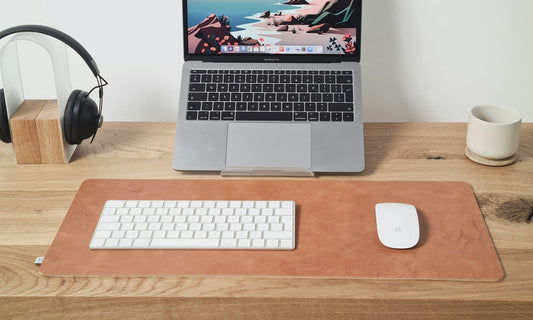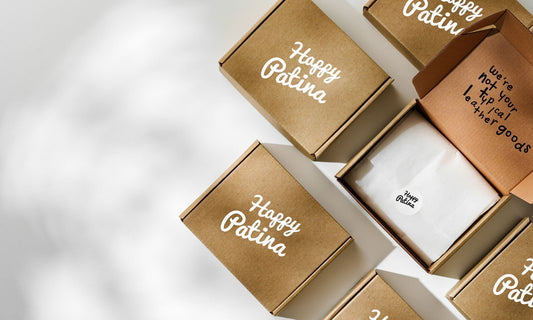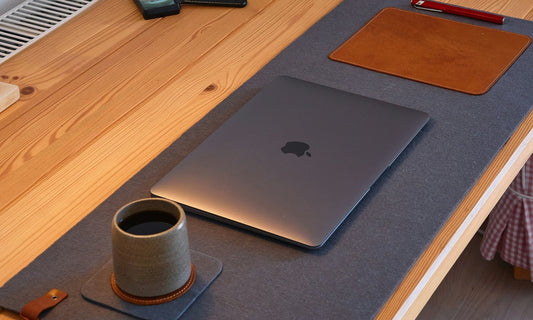
Materials That Calm the Mind: Leather, Wood and Stone
Oscar ArenasThere’s a quiet wisdom in materials that have been here longer than we have — leather that softens with time, wood that carries the scent of nature, and stone that remembers the earth it came from. These materials speak softly, but they have a way of steadying the mind.
In a world filled with screens and synthetic surfaces, surrounding yourself with natural textures can transform the way you think, feel, and create. At HappyPatina, we believe that design begins not with decoration, but with material — because what you touch shapes what you think.
1. The Psychology of Natural Materials
We are tactile beings. Our minds calm when our senses encounter texture, weight, and warmth. Natural materials connect us to the physical world — a grounding counterbalance to the constant abstraction of digital life.
Studies in environmental design have shown that materials like leather, wood, and stone reduce stress and improve focus. They evoke trust and familiarity, triggering the same sense of ease we feel in nature.
Touching something real helps us remember that we are, too.
When a workspace incorporates these materials, it becomes more than a place to work — it becomes a space to breathe.
2. Leather — The Warmth of Time
Leather has a unique quality: it grows better, softer, and richer with use. Unlike plastic or coated materials that try to resist time, leather collaborates with it. Each mark and shade is a quiet record of presence.
At HappyPatina, we choose vegetable-tanned leather because it ages honestly. Its texture changes subtly under light and touch, mirroring the rhythm of its owner’s life. That relationship — between material and human — creates familiarity and comfort.
A leather Desk Pad or Valet Tray brings that same feeling of continuity to your workspace. Each item becomes not just a tool, but a companion.
Leather doesn’t hide its story; it wears it proudly.
3. Wood — The Rhythm of Nature
Wood brings organic rhythm into any room. Its grain patterns are nature’s fingerprints — never repeated, always balanced. The warmth of oak, ash, or walnut creates an environment that feels alive, stable, and restorative.
Wood balances technology’s cold precision with humanity’s warmth. A simple wooden desk or accessory grounds the digital with something tactile and timeless. The faint scent of wood, the way it absorbs sound, the way it ages — all invite stillness and focus.
Pairing wood with leather amplifies the calming effect. Both materials evolve gracefully, and together they create visual and sensory harmony — a workspace that feels connected to the natural world.
Wood slows time — it reminds you to work at the pace of thought, not impulse.
4. Stone — The Beauty of Permanence
If leather represents time and wood represents rhythm, stone represents permanence. It brings grounding energy — cool, steady, unchanging. In spaces where thoughts race and ideas scatter, stone anchors attention.
A small marble paperweight, a ceramic mug, or a travertine lamp base adds tactile weight to your workspace. These quiet elements don’t draw attention; they offer balance. They remind you that strength doesn’t have to shout — it can simply endure.
Where wood breathes and leather moves, stone listens.
5. The Harmony of Contrast
The secret of slow design lies not in uniformity, but in harmony. When materials contrast naturally — soft leather against solid wood, smooth stone beside warm light — they create tension that feels alive yet calm.
This contrast mirrors life itself: strength and softness, structure and freedom, permanence and change. Designing a workspace with intention means balancing these qualities — building an environment that feels both productive and peaceful.
At HappyPatina, we use this principle in every object we create. A leather accessory might rest on a wooden desk; a brass key ring might sit beside a linen-bound notebook. Each combination is an invitation to slow down and connect.
6. Designing a Calm Workspace
To create a workspace that feels centered, think of it as a composition. Let materials lead, not color. Choose a limited palette of natural tones — tan, beige, walnut, stone gray — and let texture be your accent.
Practical Tips:
- Use a leather Desk Pad to define your main workspace zone.
- Add a wooden element, like a tray, pencil holder, or desk shelf, to introduce rhythm and warmth.
- Incorporate a piece of stone or ceramic for visual weight and grounding.
- Keep surfaces matte — reflection disrupts calm.
- Embrace negative space. Emptiness is part of the design.
Calm isn’t created by adding more — it’s revealed by removing what doesn’t belong.
7. Slow Design as a Daily Practice
Slow design isn’t just about how things look — it’s about how they make you feel. It’s a mindset that values process over speed, substance over novelty, and meaning over noise. It invites you to interact with your surroundings consciously, to touch and notice the world again.
When you choose natural materials, you choose connection. You participate in a longer story — one that existed before you and will continue after. That continuity brings peace, perspective, and appreciation for time itself.
This is what we call A Life Well Crafted — the art of surrounding yourself with objects that breathe, balance, and endure.
Key Takeaways
- Natural materials calm the mind by connecting us to the physical world.
- Leather, wood, and stone create harmony through warmth, rhythm, and permanence.
- Slow design values process, material honesty, and emotional connection.
- A calm workspace starts with intention — and ends with balance.
FAQs
Why do natural materials feel more calming than synthetic ones?
Because our senses recognize organic patterns and textures. Natural materials reflect irregularity and warmth, helping our brains relax in familiar ways that plastic or metal cannot.
How can I bring natural materials into a modern office?
Start small — a leather desk pad, a wooden accessory, or a ceramic detail. Even one tactile element can soften the digital edge of a workspace.
What is “slow design” in practical terms?
It’s an approach that prioritizes longevity, authenticity, and meaning. Objects are made to last, to age, and to tell stories — not to follow trends or be replaced quickly.
Explore More Guides
- The Return of Craft — Why Authentic Design Still Matters
- The Timeless Desk — How to Build a Workspace That Inspires You
- A Life Well Crafted — The Philosophy Behind HappyPatina
Final Thoughts
Materials matter. They influence not only how your workspace looks, but how it feels — how you work, rest, and think. Leather, wood, and stone each carry a rhythm of nature into your daily routine, reminding you that simplicity can be deeply luxurious.
In a fast world, these materials ask us to slow down — to create deliberately, to work with intention, and to live surrounded by things that endure.
Explore the Office Collection →



